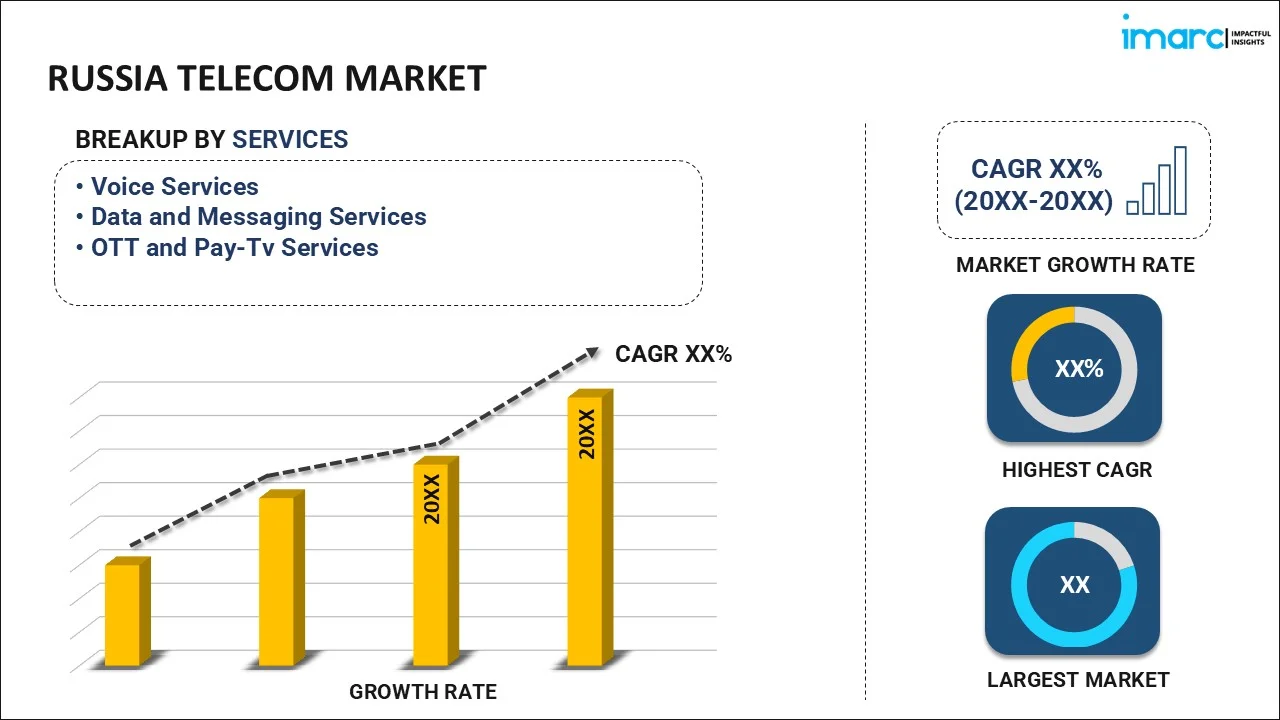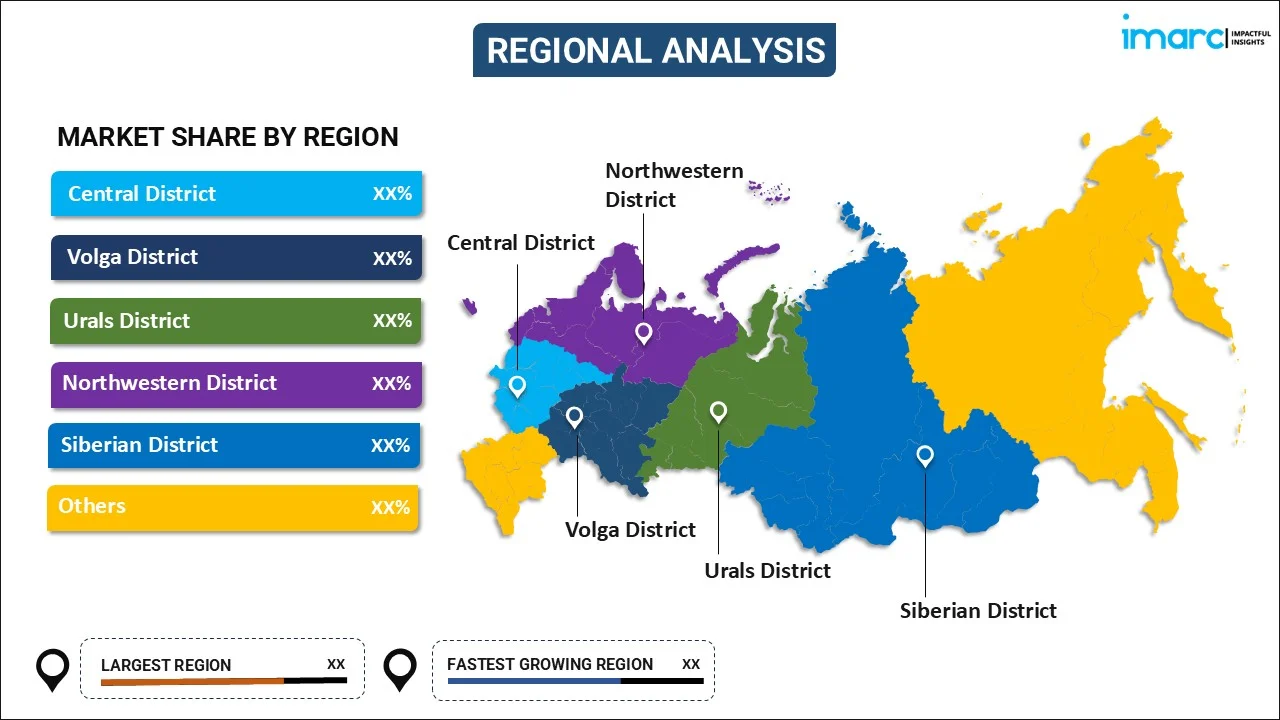
Russia Telecom Market Report by Services (Voice Services, Data and Messaging Services, OTT and Pay-Tv Services), and Region 2025-2033
Russia Telecom Market Overview:
The Russia telecom market size is projected to exhibit a growth rate (CAGR) of 4.1% during 2025-2033. The market is experiencing steady growth driven by the implementation of policies promoting improvements in digital infrastructure, rising smartphone usage among the masses, rapid network modernization and 5G deployment, and continual technological advancements. The Russia telecom market share is also expanding as local operators leveraging these trends to strengthen their position.
|
Report Attribute
|
Key Statistics
|
|---|---|
|
Base Year
|
2024
|
|
Forecast Years
|
2025-2033
|
|
Historical Years
|
2019-2024
|
| Market Growth Rate 2025-2033 | 4.1% |
Russia Telecom Market Trends:
Government Initiatives and Regulatory Framework
Government support in the promotion activities across the telecom sector through various campaigns and regulatory frameworks is driving the market. Policies governing the improvement of digital infrastructure, expansion of broadband access, and the deployment of advanced technologies such as 5G are playing a crucial role in the market expansion. Additionally, supportive regulatory measures aimed at facilitating the licensing processes and providing incentives to telecommunication operators to invest in rural and unserved areas have, in essence, increased the pace of market growth. Furthermore, government policies promoting public-private partnerships are accelerating the development and deployment of next-generation telecom infrastructure. The Russia telecom market forecast indicates continued growth driven by government initiatives, with an emphasis on enhancing digital infrastructure, expanding broadband access, and fostering advancements in 5G technology.
Increasing Internet Penetration and Smartphone Usage
The rising internet penetration and the widespread adoption of smartphones are key drivers of the market. The proliferation of inexpensive smartphones is resulting in increased access to the internet, higher data consumption, and consequently better penetration of telecom services. The trend is additionally supported by the growing popularity of mobile apps, social media, and streaming services, all of which are requirements for robust and high-speed internet connectivity. In response to this demand, investments from telecom operators are going into 4G network expansion and the implementation of super-fast 5G technology, promising more reliable internet services. Further innovations and expansions in the sector are expected as internet penetration continues to grow in response to the needs expressed by consumers. The Russia telecom market share is expected to increase as internet penetration rises, driven by the widespread adoption of smartphones, enhanced data usage, and the growing demand for high-speed connectivity through 4G and 5G technologies.
Technological Advancements and Network Modernization
The market is also driven by continuous technological advancements and network modernization. Telecom operators are investing heavily in upgrading their existing infrastructure to achieve faster, more reliable, and higher capacity networks, capable of facilitating ultra-fast internet speeds like 5G. Additionally, recent advancements in fiber optics are significantly enhancing data transmission capabilities, providing a robust backbone for modern telecom networks and ensuring seamless connectivity for consumers. Additionally, the integration of AI and machine learning (ML) technologies in network management and customer service is enhancing operational efficiency and enriching user experiences. These advancements meet current market demands as well as also pave the way for future innovations and business opportunities within the telecommunications industry. The Russia telecom market growth is also driven by the growing user demand for high-quality, high-speed services, which not only meet current industry needs but also pave the way for future developments.
Russia Telecom Market News:
- January 2025: T2 announced it had completed telecom infrastructure for three new metro stations on the Troitskaya line in southern Moscow. The stations—Kornilovskaya, Kommunarka, and Novomoskovskaya—are equipped with 3G and 4G coverage, ensuring stable connections before their official opening. This development is part of T2's efforts to improve communications for Moscow's expanding metro system.
- November 2024: T2 (formerly Tele2 Russia) launched Voice over LTE (VoLTE) services across 23 regions, with nationwide coverage expected by year-end. The implementation uses domestic technology from the Russian company Protey, enhancing communication quality. Over 53% of voice traffic in these regions is now carried on the 4G network.
- April 2024: MTS subsidiary Irteya announced it would begin producing 4G LTE and 5G base stations in 2024, with plans to manufacture 10,000-20,000 units annually starting in 2025. The production will use OpenRAN architecture, and the company aims for exclusive use of Russian-made base stations by 2028. The initiative involves investments exceeding 4 billion rubles by 2027.
- July 2024: Rostelecom, one of Russia’s largest providers of digital services, announced it has expanded its GPON fiber network to over 5,000 households in Volgograd, enhancing digital communication services across multiple districts. This development aligns with Rostelecom's investment strategy to improve optical internet access in rural areas, providing high-speed connectivity to more residents.
- June 2024: Russia's Bureau 1440 successfully tested laser communication between satellites, achieving data transfer speeds of 10 Gbps over 30 km. These advancements aim to enhance satellite internet services, especially in remote areas, and support future 5G implementations. This technology will also enable Russians to communicate in areas where it is not feasible to set up ground base stations.
Russia Telecom Market Segmentation:
IMARC Group provides an analysis of the key trends in each segment of the market, along with forecasts at the country level for 2025-2033. Our report has categorized the market based on services.
Services Insights:

- Voice Services
- Wired
- Wireless
- Data and Messaging Services
- OTT and Pay-Tv Services
The report has provided a detailed breakup and analysis of the market based on the services. This includes voice services (wired and wireless), data and messaging services, and OTT and pay-tv services.
Regional Insights:

- Central District
- Volga District
- Urals District
- Northwestern District
- Siberian District
- Others
The report has also provided a comprehensive analysis of all the major regional markets, which include Central District, Volga District, Urals District, Northwestern District, Siberian District and Others.
Competitive Landscape:
The market research report has also provided a comprehensive analysis of the competitive landscape. Competitive analysis such as market structure, key player positioning, top winning strategies, competitive dashboard, and company evaluation quadrant has been covered in the report. Also, detailed profiles of all major companies have been provided.
Russia Telecom Market Report Coverage:
| Report Features | Details |
|---|---|
| Base Year of the Analysis | 2024 |
| Historical Period | 2019-2024 |
| Forecast Period | 2025-2033 |
| Units | Billion USD |
| Scope of the Report | Exploration of Historical Trends and Market Outlook, Industry Catalysts and Challenges, Segment-Wise Historical and Future Market Assessment:
|
| Services Covered |
|
| Regions Covered | Central District, Volga District, Urals District, Northwestern District, Siberian District, Others |
| Customization Scope | 10% Free Customization |
| Post-Sale Analyst Support | 10-12 Weeks |
| Delivery Format | PDF and Excel through Email (We can also provide the editable version of the report in PPT/Word format on special request) |
Key Benefits for Stakeholders:
- IMARC’s industry report offers a comprehensive quantitative analysis of various market segments, historical and current market trends, market forecasts, and dynamics of the Russia telecom market from 2019-2033.
- The research report provides the latest information on the market drivers, challenges, and opportunities in the Russia telecom market.
- Porter's five forces analysis assist stakeholders in assessing the impact of new entrants, competitive rivalry, supplier power, buyer power, and the threat of substitution. It helps stakeholders to analyze the level of competition within the Russia telecom industry and its attractiveness.
- Competitive landscape allows stakeholders to understand their competitive environment and provides an insight into the current positions of key players in the market.
Key Questions Answered in This Report
IMARC estimates the Russia telecom market to exhibit a CAGR of 4.1% during 2025-2033.
Key factors driving the Russia telecom market include the growing need for high-speed internet, mobile connectivity, and data services. The expansion of 5G networks, rising investments in telecom infrastructure, and advancements in digital technologies are further offering a favorable market outlook.
Need more help?
- Speak to our experienced analysts for insights on the current market scenarios.
- Include additional segments and countries to customize the report as per your requirement.
- Gain an unparalleled competitive advantage in your domain by understanding how to utilize the report and positively impacting your operations and revenue.
- For further assistance, please connect with our analysts.
 Inquire Before Buying
Inquire Before Buying
 Speak to an Analyst
Speak to an Analyst
 Request Brochure
Request Brochure
 Request Customization
Request Customization




.webp)




.webp)












